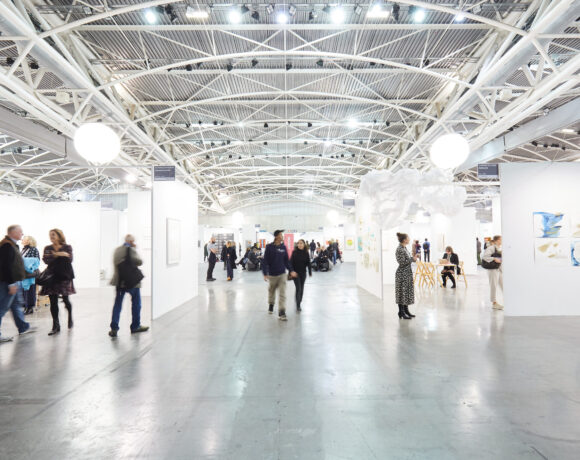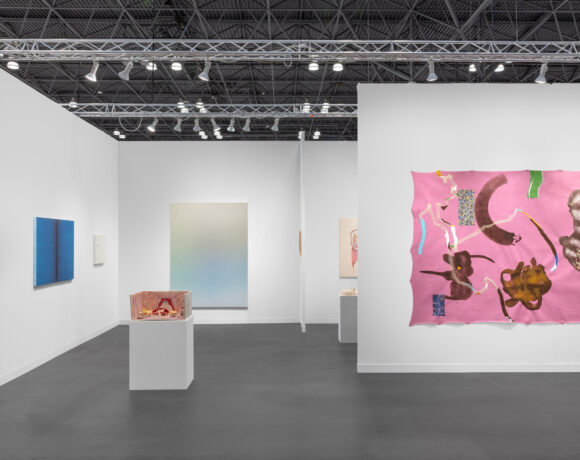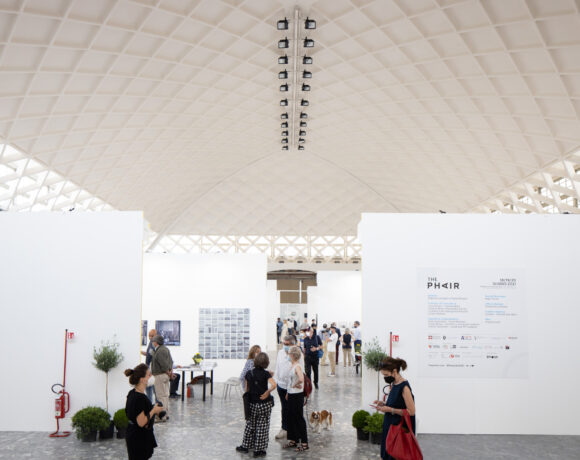The 24th edition of MiArt opens from 5th to 7th April to the public after the invitation only preview on Thursday, at Pavilion 3 in Fieramilanocity, flanked by a very rich city schedule available on the website www.milanoartweek.it. The international fair of modern and contemporary art in Milan, directed for the third consecutive year by Alessandro Rabottini, proposes a path divided into 7 sections to present 185 galleries (of which 75 are international) that will be confronted with the motto hold everything dear, title of a poem by Gareth Evans, curator of the Whitechapel Gallery in London. The phrase is at the same time an observation of the apprehension with which art looks at reality and an invitation to attention tout court, in an age in which the conflicting coexistence of poetics and different styles reflects the bewilderment of the individual in front to the contradictions of the contemporary.
Among the most urgent issues the theme of consumerism stands out, to which the installation by Jon Kessler (Edoardo Secci) refers, a circular procession made of nativity figurines and other kitsch fetishes otherwise destined to the landfill ironically controlled by a smartphone installed on a selfie stick. Erratum, an exciting arrangement by Latifa Echakhch (Kaufmann Repetto Gallery) made with the colored shards of hundreds of broken tea glasses alludes to the phenomenon of over production. The violent destruction of these objects and the fact that they are poor series reproductions of the traditional chalices of Morocco, the country of origin of the artist, adds the question of the crisis of local cultures in the globalized world.
In some way connected to this aspect is the fascination for a nature from time to time perceived as utopian, artificial, ambiguous or elusive. In this regard, the dialogue between the works of Giovanni Kronenberg and Florian Roithmayr in the Renata Fabbri stand is remarkable: the first presents samples of natural elements reworked according to the philosophy of the minimum (but decisive) intervention, while the second observes the way in which the physical and chemical reactions born from the interaction between artificial materials, such as the injection of polyurethane foam into the plaster, produce forms with a deceptively biomorphic appearance. Federico Tosi (Monica de Cardenas) creates suggestive cement fossils that seem to prefigure a distant post-atomic future, while Namsal Siedleck (DVIR gallery / Magazzino) protects a cactus already buried in precious silver casings. Also very classic at first sight representations, such as the technicolor pornographic flowers painted by Marc Quinn (Contini Art Gallery) or the evocative photographic landscapes by Elger Esser (Alessandra Bonomo) printed on coppery silver leaf, imply a nature irreparably adulterated and subject to human aesthetics. The sculpture by Ariel Schlesinger (Galleria Massimo Minini) refers to nature as a metaphor of tenacity and resistance, a bronze branch that feeds and preserves an inexhaustible burning flame.
In the era of instantaneousness and telematic ubiquity the loss of historical memory and fixed points scares: this is reflected in the archives of Lucia Tallova (Soda Gallery), which catalogs personal and other memories in alienating architectural settings with a historiographical method, and the conceptual assemblies of Farah Khelil (Officine dell’Immagine) that make traditional and technological devices for the conservation of knowledge implode into objects that are at once dense and rarefied. The intricate installations by Chiharu Shiota (Mimmo Sconamiglio) interpret the reminiscence as a visceral tension between presence and absence, while Franco Guerzoni’s Archeologies (Studio G7) interprets the passage of time as a stratigraphic superimposition of materials.
If memory is weak, even identity becomes more and more chameleonic: on the infinite variations of the self, is centered Urs Lüthi’s poetics (Otto Gallery) and Ulay‘s giant posters – protagonist (this time without Marina) of the Richard Saltoun gallery stand – are played on the display of an ambiguous gender identity. The work by Yves Scherer (Gallleriapiù) is colder but not less engaging, combining memories of his private life, fan fictions and celebrity cultures in intriguing voyeuristic devices. At the fair, the artist presents a clone of himself (made with a 3D printer from old family videos) while playing on a sensual flesh-colored carpet under the watchful eye of Kate Moss in a display case. The search for identity in fragmentation and analysis can be a suggestion to look at both John Coplans’s monumental self-portraits (P420) and Vasilis Papageorgiou’s environmental conceptualizations (UNA) that reflects on the essence of aggregation places with very refined deconstructions and abstractions.
There is no lack of quotations from the history of the art of the past, as in the intriguing still life by Keith Edmier (Mimmo Sconamiglio), which materializes in the form of sculpture some floral compositions present in famous paintings of seventeenth-century Italian painting. Or in the luminous sculpture by Bethan Huws, (Vistamare) which reproduces the famous ready made by Duchamp. All the historical phases of passage generate uncertainty in the market and for this reason the artists question the status of the artwork: Simon Linke (Thomas Brambilla) reproduces the advertisements on Artforum of some of his successful colleagues with a pasty and sensual painting, the Untitled sculpture by Henrik Olesen (Cabinet), is formed by an empty display case, while Edson Luli in This is not the artwork (Prometeogallery) hypothesizes the value of a statement wrapped by cellophane.
In the absence of predominant artistic addresses, many collectors choose to rely on the masters already permanently consecrated by auctions and museum exhibitions that have managed over the years to evolve their poetics. An emblematic case is David Hockney (Lelong & Co.), the highest-paid living artist in the world – last November his Portrait of an Artist (pool with two figures), 1972 was auctioned for 90.3 million of dollars. – Heir of the great avant-garde tradition and stubborn supporter of the centrality of painting through uninterrupted research that also includes new media, presents at the fair a series of color graphics made with the iPad. Even among young people there is a significant return to figurative art, with no more separation between analogical and technological media: if even Ed Atkins (Cabinet), guru of digital art, does not disdain the ink and the sheet of paper to paint his his sci-fi visions, we understand how figurative art is back. The knowledge of traditional techniques goes hand in hand with the ability to reinvent the languages and to experiment contaminations between practices, as Michelangelo Pistoletto teaches that updates the characters screen-printed on his mirrors portraying a family of tourists surprised in taking a selfie ( whose image will overlap with that of the many visitors who will be photographed in the works of the master).
To conclude, we would like to highlight two stands with a museum imprint: that of Hauser & Wirth dedicated to Paul McCarthy, whose anguishing visions operate a merciless criticism of the system of dominant values in the Western world through Freudian symbolism linked to sex and food, and Massimo de Carlo’s one with the pop-kitsch installation by Rob Pruitt, an ambiguous merchant of apparently innocent delights that conceals a merciless criticism of the mystifications of contemporary society. Also in 2019 MiArt, which was experiencing a deep crisis a few years ago, confirms itself as a leading event for the Italian and international public. The involvement of young and competent curators and the change in orientation of the Ente Fiera, which now focuses decisively on the event in terms of investment, has made it possible to bring together almost all the best Italian galleries in the contemporary sector and some international stars whose choices influence the market is decisive.
Info:
 Lucia Tallova (Soda Gallery)
Lucia Tallova (Soda Gallery)
 Farah Khelil, Historie en flottaison, 2018 papier maché (Histoire de l’art – Ernst Gombrich), piano cord, acrylic
Farah Khelil, Historie en flottaison, 2018 papier maché (Histoire de l’art – Ernst Gombrich), piano cord, acrylic
 Chiharu Shiota, State of being (photographs), 2018 struttura metallica, filo, fotografie (Mimmo Sconamiglio)
Chiharu Shiota, State of being (photographs), 2018 struttura metallica, filo, fotografie (Mimmo Sconamiglio)
 Urs Lüthi, Selfportrait as Kafka at the time he wrote his novel the Metamorphosis, 2014 aluminium cast on wooden base (Otto Gallery)
Urs Lüthi, Selfportrait as Kafka at the time he wrote his novel the Metamorphosis, 2014 aluminium cast on wooden base (Otto Gallery)
 Urs Lüthi, Selfportrait as Kafka at the time he wrote his novel the Metamorphosis, 2014 aluminium cast on wooden base (Richard Saltoun)
Urs Lüthi, Selfportrait as Kafka at the time he wrote his novel the Metamorphosis, 2014 aluminium cast on wooden base (Richard Saltoun)
 Keith Edmier, Still life of flowers with silver pitcher (Andrea Belvedere 1652-1732), 2018 acrilico dentale, poliuretano, pittura acrilica, maiolica (Mimmo Sconamiglio)
Keith Edmier, Still life of flowers with silver pitcher (Andrea Belvedere 1652-1732), 2018 acrilico dentale, poliuretano, pittura acrilica, maiolica (Mimmo Sconamiglio)
 Bethan Huws, Tour, 2007 tubo di vetro bianco con gas argon neon montato su Perspex (Vistamare)
Bethan Huws, Tour, 2007 tubo di vetro bianco con gas argon neon montato su Perspex (Vistamare)
 Simon Linke, Joel Shapiro at Pace London, 2017 oil on canvas (Thomas Brambilla)
Simon Linke, Joel Shapiro at Pace London, 2017 oil on canvas (Thomas Brambilla)
 Henrik Olesen, Untitled 2, 2019, glass, glue, metal brackets (Cabinet)
Henrik Olesen, Untitled 2, 2019, glass, glue, metal brackets (Cabinet)
 Edson Luli, This is not the artwork, 2019. Inkjet print on cotton paper, PVC translucent (Prometeogallery)
Edson Luli, This is not the artwork, 2019. Inkjet print on cotton paper, PVC translucent (Prometeogallery)
 Jon Kessler, Exodus, 2016 Trunk, wood, aluminium, rubber wheels, found figurines, iPhone with selfie stick, LCD screen and motor (Eduardo Secci Contemporary)
Jon Kessler, Exodus, 2016 Trunk, wood, aluminium, rubber wheels, found figurines, iPhone with selfie stick, LCD screen and motor (Eduardo Secci Contemporary)
 Latifa Echakhch, Erratum, 2004 broken glasses site specific installation adaptable dimensions(Galleria Kaufmann Repetto)
Latifa Echakhch, Erratum, 2004 broken glasses site specific installation adaptable dimensions(Galleria Kaufmann Repetto)
 Giovanni Kronenberg (Renata Fabbri)
Giovanni Kronenberg (Renata Fabbri)
 Federico Tosi (Monica De Cardenas)
Federico Tosi (Monica De Cardenas)
 Namsal Siedleck, Cactacee, 2017, cactus, nickel (DVIR gallery Magazzino)
Namsal Siedleck, Cactacee, 2017, cactus, nickel (DVIR gallery Magazzino)
 Marc Quinn, The slopes of Mount Abu, 2010 oilon canvas (Contini)
Marc Quinn, The slopes of Mount Abu, 2010 oilon canvas (Contini)
 Elger Esser (Alessandra Bonomo)
Elger Esser (Alessandra Bonomo)
 Ariel Schlesinger, At arm’s length II, 2017 – Alluminio sabbiato, olio per lampade, fuoco (Massimo Minini)
Ariel Schlesinger, At arm’s length II, 2017 – Alluminio sabbiato, olio per lampade, fuoco (Massimo Minini)
 Yves Scherer, Boy, 2019 (Gallleriapiù)
Yves Scherer, Boy, 2019 (Gallleriapiù)
 John Coplans, Knees with Fist, Side View, 1984 gelatin silver print (P420 Arte Contemporanea)
John Coplans, Knees with Fist, Side View, 1984 gelatin silver print (P420 Arte Contemporanea)
 Vasilis Papageorgiou (UNA galleria)
Vasilis Papageorgiou (UNA galleria)
 David Hockney, 4 Blue Stools, 2014 Montage photo imprimé sur papier et monté sur aluminium (Lelong Co.)
David Hockney, 4 Blue Stools, 2014 Montage photo imprimé sur papier et monté sur aluminium (Lelong Co.)
 Ed Atkins, Untitled, 2019, ink and acrylic on paper (Cabinet, London)
Ed Atkins, Untitled, 2019, ink and acrylic on paper (Cabinet, London)
 Michelangelo Pistoletto, Selfie – La Famiglia, 2018 (Galleria Continua)
Michelangelo Pistoletto, Selfie – La Famiglia, 2018 (Galleria Continua)
 Rob Pruitt, YOU + I (Massimo De Carlo)
Rob Pruitt, YOU + I (Massimo De Carlo)
Graduated in art history at DAMS in Bologna, city where she continued to live and work, she specialized in Siena with Enrico Crispolti. Curious and attentive to the becoming of the contemporary, she believes in the power of art to make life more interesting and she loves to explore its latest trends through dialogue with artists, curators and gallery owners. She considers writing a form of reasoning and analysis that reconstructs the connection between the artist’s creative path and the surrounding context.






NO COMMENT